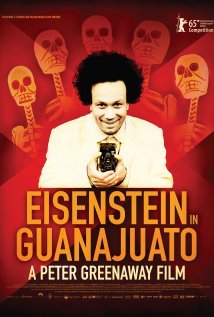Peter Greenaway seemingly bursts gloriously back to life with a film about one of film's greatest directors going to Mexico in order to make a movie. Moving away from Dutch artists Rembrandt and Goltzius and his frequent use of tableaux in order to make a film that is living and breathing and is very much the very definition of a motion picture.
Nominally the story of what happened when Sergei Eisenstein went to Mexico after failing to make a film in Hollywood. The film is less concerned with the making of QUE VIVA MEXICO than it is with Eisenstein's sensual and intellectual awakening he had with Palomino Canedo. At the start Greenaway says that the film could be called THE TEN DAYS THAT SHOOK EISENSTEIN, a sentiment stated at the end of the film by Eisenstein himself. We watch as the two men become close and then are broken apart by various forces at play in Mexico and the making of the film.
I can not in good conscious begin to discuss the film on an intellectual and thematic level. Where I had attempted it with some of his recent films, the Rembrandt duo (NIGHTWATCHING and REMBRANDT J'ACCUSE) and GOLTZIUS AND THE PELICAN COMPANY, in the current case the film is much too complex and much too distracting (in a good way) for me to have actually even begun to grasp everything that is going on. In it's way the film hearkens back to the TULSE LUPER films which had a great deal going on visually and thematically and dared you to keep up. Both in this film and the TULSE LUPER movies Greenaway has made complex tales that need to be digested as complete entities and not picked apart as pieces.
Adding to the problem is that the viewing of the film I saw was tied to the NewFest screening of the film that happened last night. I did not have the time to really sit with the film as I would have liked in order to full comprehend it's complexities.I had one pass to get it all in and it was sink or swim, with little chance to notes, I had to jjust let the film wash over me.
What amazed the hell out of me was the technical virtuosity with which Greenaway attacked the filmmaking process. Using just about every trick in the book the director breaks the almost static bonds of his previous films in order to make a film that you have to watch with new eyes. Where GOLTZIUS and NIGHTWATCHING (and even some of his other films) seemed to be almost plays performed on a platform in a room where characters come and go in an approximation of theater, here Greenaway is out in the world in real locations. Where in the earlier films the camera was almost motionless, here it is constantly moving and circling. Even the shots that aren't in motion have action, multiple image, or over lays added to them. Its as if Greenaway is taking his many recent lectures to heart and reinventing how he shows us the world. EISENSTEIN IN GUANAJUATO is a glorious celebration of cinema and the craft of cinema and of those that went before. Greenaway may claim cinema is dead but in giving us a feast like EISENSTEIN he simply proves it's become something else when manipulated by a master.
This is the sort of Greeaway film that made me fall in love with him some thirty years ago.
And to be fair, this is a film that is not going to be for all audiences, never mind the full frontal male nudity and sex, this is, as I said above a complex film that is actually about something, love loss, humanity done in a way that challenges and delights it's audience...
...which leads me to a slight digression this is possibly the most emotional of the director's films. Somewhere along the way Greenaway stated that he makes films more for the head than the heart, which is a very true statement. There is a coldness and an order to films like THE COOK,THE THIEF... or DROWNING BY NUMBERS or BELLY OF AN ARCHITECT. The world is ordered. Greenaway if playing with ideas not emotions One need only watch the constant reliance on the controled universes that are his "stage bound" films (BABY OF MACON, GOLTZIUS, PROSPERO'S BOOKS and others) to see this. Here,, however there is real emotion as Eisenstein awakens a part of himself that he had kept asleep. The injection of emotion into the film makes the end of the film touching in a way that the earlier films never were. The world is not truly controled and ordered, we are, for one of the few times in Greenaway's 45 year career in the real world among real people where anything and and will happen. Yes Greenaway is in control of the images, but I never felt he was in control of the characters, they were entirely at the mercy of their feelings.
I adore this film with my heart as well as my head.
After only one viewing I don't know what I fully think of the film nor do I know what it's fully all about, however I don't think I would be far off in saying that it is the work of a master film director working at the top of his game. It is in a way a reinvention if not of cinema then of his own private cinema. It is a film that I am looking forward to seeing again and again once the film hits American screens in January when Strand Releasing blesses us with the film.


No comments:
Post a Comment